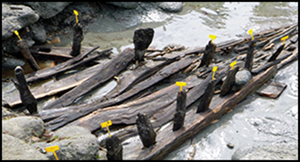Article contents
An estuarine tidescape of production: terrestrial laser scanning of fixed fishing structures and a tide mill in the Léguer Estuary, Brittany
Published online by Cambridge University Press: 01 September 2020
Abstract

Terrestrial laser scanning (TLS) provides a means of rapid and highly accurate survey of archaeological excavations and structures at landscape scales, and is particularly valuable for documenting tidal environments. Here, the authors use TLS to record tidal fixed fishing structures and a tide mill within the Léguer Estuary at Le Yaudet, in north-west France. As part of a comprehensive resource-exploitation system, the early medieval (sixth to eighth centuries AD) structures lie within, and exploit different parts of, the tidal frame. The results are used to quantify production within an estuarine landscape associated with seignorial or monastic control of environmental resources.
- Type
- Research Article
- Information
- Copyright
- Copyright © Antiquity Publications Ltd, 2020
References
- 4
- Cited by


